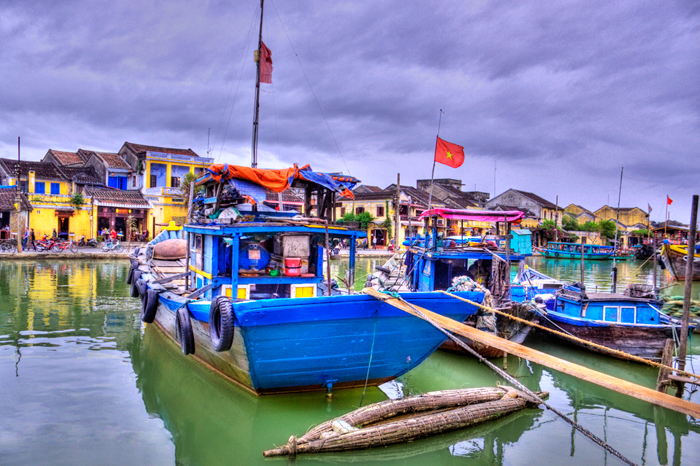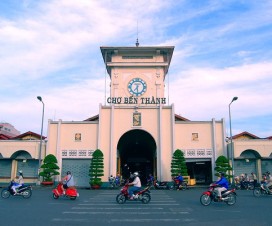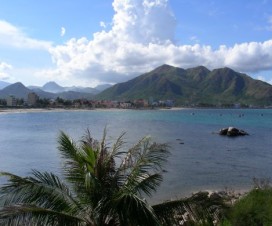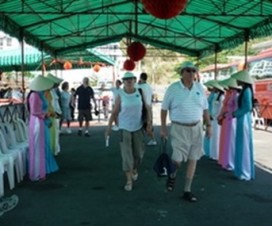The Thu Bon River basin covers an area of over 10,000 square kilometers in Quang Nam Province and is ranked fourth for hydropower potential in Vietnam. But to the local people, the river is considered the lifeblood that has helped raise many generations of residents on both banks.
 Originating from Ngoc Linh Mountain in Dak Glei District, Kon Tum Province, the Thu Bon River flows into the sea via Cua Dai Estuary in Hoi An Town in Quang Nam Province. A tributary runs to the Vinh Dien River to pour water into the Han River in Danang City. And before going to the sea, part of the Thu Bon River courses through the Truong Giang River to pour into An Hoa Tam Quang Bay in Nui Thanh District.
Originating from Ngoc Linh Mountain in Dak Glei District, Kon Tum Province, the Thu Bon River flows into the sea via Cua Dai Estuary in Hoi An Town in Quang Nam Province. A tributary runs to the Vinh Dien River to pour water into the Han River in Danang City. And before going to the sea, part of the Thu Bon River courses through the Truong Giang River to pour into An Hoa Tam Quang Bay in Nui Thanh District.
From Vinh Dien up to Giao Thuy T-junction, one can see mulberry fields along the river banks. A folk art was born here, using literary figures to show the intelligence, optimism and sentiments of the locals.
For a long time, the Thu Bon River has been famous for the craft of raising silkworms and weaving fabric, and for the endless green mulberry farms stretching along its banks. Along the banks are many well-known craft centers such as Thanh Ha for pottery, Phuoc Kieu for bronze casting, Kim Bong for carpentry, Tra Que for vegetables, Ma Chau for silk, Phu Chiem for rice paper and Que Minh for conical hats.
Along the banks are numerous wharves and markets reflecting the rural lifestyle, and simple villages steeped in memories. The Trung Phuoc floating market is the busiest trading place in the region.
The Thu Bon River is likened to the Ganges River in India because it is a silt source forming the delta. Strangely, despite cultural interchange, the very northern and southern banks of the Thu Bon River have their own cultural differences characterised by voices, routine activities, festivals and even relics from each area. In the southern bank, the Champa culture still figures in daily activities, customs and festivals for local residents.
The Thu Bon Goddess Festival falls on the 12th day of the second lunar month, and is held solemnly in My Luoc Village, where a water procession is the most important part of the ceremony. Locals scoop water from the Thu Bon River and pour it into the jars, then carry them on their heads back to the village in deference to the river.
In the upstream district of Hiep Duc, locals set up a long house with an altar on the top to suspend a boat. The rituals around the boats aim to honor the “river mother” in the spiritual lives of locals.
For tourists who are interested in a river tour or an eco-tour to the countryside of Vietnam, taking a boat ride on the Thu Bon River may be their most enjoyable experience when they come to Quang Nam-Danang.
They can also visit Dai Buong, an orchard village similar to those found in the southern region with rambutan, durian and mangosteen. Tourists will have the chance to enjoy durian wine, which has an unforgettable flavor.
In Hon Kem-Da Dung area, where the river is narrowed by the cliffs on either bank, novelist Thai Ba Loi stood and gazed at the Thu Bon River and regretted: “On the river, hydropower dams were built, thousands of hectares of forest have been destroyed. Sand is exploited excessively. With such unethical behavior toward nature, people must reap what they sow.”
If the Thu Bon River, a water mother who opens her arms to hold the holy land which is home to the epic legends of Quang Nam, a traditional cultural stream filled with the colors of the central region’s countryside, and an attractive tour itinerary, is not protected from being destroyed by humans, it cannot retain its beautiful images in the minds of people who love the land.
(Source: SGT)




